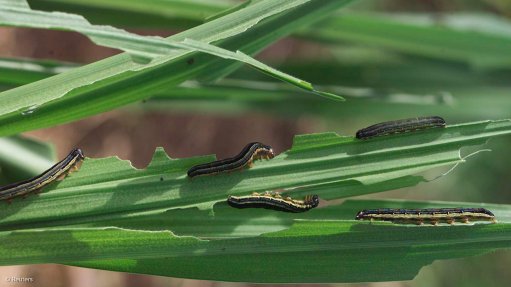
THE FALL ARMYWORM If the outbreak cannot be contained, it can affect maize production by almost 80%
Last month, independent grain producers’ support organisation Grain SA said that reports from KwaZulu-Natal and the Eastern Cape mentioned that the Fall Armyworm – also known as the Spodoptera Frugiperda – has established itself mainly in maize but also in sorghum, cotton, some vegetables and possibly also in sunflower.
However, First National Bank Business senior agricultural economist Paul Makube says that, owing to early detection of the worm, South Africa is in a good position to deal with its effect.
If the outbreak cannot be contained, he notes, it can affect maize production by almost 80%.
“However, the country has Bt maize, which means that it is genetically modified and susceptibility is minimal.”
Makube explains that the pest has travelled from the Americas through North Africa and found its way in Southern Africa, noting that restrictions on exports and imports will be ineffective as the pest is airborne and does not need to be carried in harvested products to enter the country.
Meanwhile, the Department of Agriculture, Forestry and Fisheries (DAFF) has implemented the South African Emergency Plant Pest Response Plan (SAEPPRP) and is fast-tracking certification of pesticides, monitoring and dissemination of technical information on control options.
The DAFF states that the aim of the SAEPPRP is to outline effective emergency rapid response involving the detection, identification and mitigation of a plant pest incursion in South Africa.
This is ultimately to prevent the spread of a pest before the population becomes established.
The SAEPPRP also facilitates communication between local, national and international government agencies, academia, and plant industry professionals when response actions are needed and when unaffected areas need to be protected to maintain production.
Makube explains there are immediate costs to the affected farmers, owing to the need to source registered and effective pesticides, which can be expensive.
Industry association CropLife’s specialist technical group, Insecticide Resistance Action Committee (IRAC), drafted the Mode of Action (MoA) classification scheme, which provides growers, advisers, extension staff, consultants and crop protection professionals with a guide to the selection of acaricides or insecticides for use in an effective and sustainable acaricide or insecticide resistance management strategy.
“The MoA is endorsed by the IRAC to ensure that farmers are aware of different MoA groups and that they use pesticides in the correct ratio and sequence,” he points out.
Many farmers who experience another lost crop following the drought can find themselves in a serious financial crisis and it can take years for them to recover.
“It is still early days, we need to have a measured approach as the pest is new to South Africa. “There are no proven remedies available for maize in the country; however, there are other chemicals that can be recommended. The DAFF has already set in motion that new remedies be registered and certified for use,” says Makube.
He concludes that the commercial sector has the capacity to control the pest when the pesticides become available and that farmers can limit the effects of infestation to ensure that the Fall Armyworm does not have extensive impact on a recovering sector.